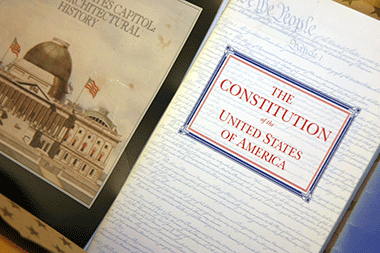VSU Celebrates Constitution Day with Exhibit in Odum Library
September 13, 2012
12-241
Jessica R. Pope Communications Specialist
VSU Celebrates Constitution Day with Exhibit in Odum Library

|
VALDOSTA -- In recognition of Constitution Day, Valdosta State
University’s Odum Library has put together an exhibit of
Constitution-related government documents in the second floor
reference area. The items will remain on display through Oct.
17.
Highlights of the exhibit include books about civics lessons, the
architectural history of the nation’s Capitol, how laws are made,
and the U.S. Constitution; the Articles of Confederation and the
American’s Creed; and information about the U.S. Patriot Act,
recent Supreme Court decisions, and the Voting Rights Act.
Emily Rogers, reference librarian, said Odum Library will also have
a website and a blog post focusing on various constitutional
resources, including information about Georgia’s signers of the
U.S. Constitution.
“On Sept. 17, 1787, the Founding Fathers signed the most
influential document in American history -- the United States
Constitution,” according to the National Constitution Center. “This
document established the framework of our government and the rights
and freedoms that ‘We the People’ enjoy today.”
U.S. Senator Robert Byrd, a Democrat from West Virginia, designated
Sept. 17 as a day to recognize all who have become citizens, either
by birth or naturalization, and to learn more about the formation
of the nation’s founding document. Constitution Day became a
national observance in 2004.
“Our ideals of freedom, set forth and realized in our Constitution,
are our greatest export to the world,” Byrd reportedly once
said.
In honor of Constitution Day, all educational institutions
receiving federal funding are required to hold an educational
program pertaining to the U.S. Constitution.
Visit
www.valdosta.edu/library/find/gov/ConstitutionDay2012.shtml to
view Odum Library’s special Constitution Day website.
Contact Emily C. Rogers at (229) 245-3748 or ecrogers@valdosta.edu to learn
more.
On the Web:
www.constitutioncenter.org
Visit
http://www.flickr.com/photos/valdostastate/sets/72157631535339248/
to view more photos.
Constitution Fast Facts
• The U.S. Constitution was written in the same Pennsylvania State
House where the Declaration of Independence was signed and where
George Washington received his commission as commander of the
Continental Army. Now called Independent Hall, the building still
stands today on Independent Mall in Philadelphia, directly across
from the National Constitution Center.
• Written in 1787, the Constitution was signed on Sept. 17. But it
wasn’t until 1788 that it was ratified by the necessary nine
states.
• The U.S. Constitution was prepared in secret, behind locked doors
that were guarded by sentries.
• Some of the original framers and many delegates in the state
ratifying conventions were very troubled that the original
Constitution lacked a description of individual rights. In 1791,
Americans added a list of rights to the Constitution. The first 10
amendments became known as the Bill of Rights.
• Of the 55 delegates attending the Constitutional Convention, 39
signed and three dissented. Two of America’s “founding fathers”
didn’t sign the Constitution. Thomas Jefferson was representing his
country in France, and John Adams was doing the same in Great
Britain.
• Established on Nov. 26, 1789, the first national “Thanksgiving
Day” was originally created by George Washington as a way of
“giving thanks” for the Constitution.
• Of the written national constitutions, the U.S. Constitution is
the oldest and shortest.
• At 81, Benjamin Franklin of Pennsylvania was the oldest delegate
at the Constitutional Convention, and at 26, Jonathon Dayton of New
Jersey was the youngest.
• The original Constitution is on display at the National Archives
in Washington, D.C. When the Japanese bombed Pearl Harbor, it was
moved to Fort Knox for safekeeping.
• More than 11,000 amendments have been introduced in Congress.
Thirty-three have gone to the states to be ratified, and 27 have
received the necessary approval from the states to actually become
amendments to the Constitution.
Source: National Constitution Center
Newsroom
- Office of Communications Powell Hall West, Suite 1120
-
Mailing Address
1500 N. Patterson St.
Valdosta, GA 31698 - General VSU Information
- Phone: 229.333.5800
- Office of Communications
- Phone: 229.333.2163
- Phone: 229.333.5983